‘Humanitarian aid’ or ‘humanitarian assistance’ is emergency help for people in some of the world’s most desperate situations. Typically, beneficiaries are facing crises like violent conflict, natural disasters or economic turmoil – or many of these threats simultaneously.
COVID-19 has compounded the urgency. In 2021, some
235 million people are expected to need humanitarian aid like food, clean water, shelter, medicine and medical care, and protection. The
countries in greatest need are Afghanistan, the Democratic Republic of Congo, Ethiopia, Sudan, Syria and Yemen. Providing humanitarian assistance to the world’s most vulnerable people is projected to cost
more than $35 billion US.
Humanitarian aid is not about creating long-term development in stable communities. Rather, it helps save lives in the here and now – no matter where people live and what they are facing. It aligns with the
universal ‘humanitarian imperative’: we all have “the right to receive aid and the right to offer it”.
This article explores the realities of humanitarian assistance. You’ll learn why it’s important and why the need is increasing. We’ll explain what Canada is doing to respond, and how you can help. You’ll learn how humanitarian aid makes a difference, not just for people suffering today, but for their futures.
- What is humanitarian aid?
- Who needs humanitarian aid?
- What’s the difference between ‘humanitarian aid’ and ‘humanitarian assistance’?
- Does humanitarian assistance make a difference?
- What are the challenges of providing humanitarian assistance?
- Why can’t people’s own countries look after them?
- What is Canada’s approach to humanitarian assistance?
- What’s the difference between humanitarian assistance and development assistance?
- What are some objections to humanitarian assistance?
- How can I help provide humanitarian assistance?
- What is humanitarian aid?
Humanitarian aid – or humanitarian assistance – is emergency help for people facing life-threatening crises. This article explores aid for people in countries facing threats like war, natural disasters, economic crises and devastating emergencies like the 2020 explosion in Beirut, Lebanon. In 2021, some
235 million people are expected to need humanitarian aid like food, clean water, shelter, medicine and protection.
Humanitarian assistance takes many forms. It may consist of material help like emergency food and water, shelter, and medical help. Logistical help includes things like rebuilding bombed water sources, transporting people to safety from flood zones and other support. Newer approaches include
cash-based assistance like ‘cash for work’, so people can meet their needs more quickly and efficiently while contributing to local economies.
 Humanitarian assistance is also critical in longer-lasting crises, like the conflict in Syria which has endured for more than a decade. Above, families in northwest Syria – where winters drop below freezing – line up for winter clothing and footwear for their children. Some children here are going barefoot. Photo: IYD Relief
Humanitarian assistance is also critical in longer-lasting crises, like the conflict in Syria which has endured for more than a decade. Above, families in northwest Syria – where winters drop below freezing – line up for winter clothing and footwear for their children. Some children here are going barefoot. Photo: IYD Relief
- Who needs humanitarian aid?
Humanitarian aid is most likely to be required by people in places rocked by natural and man-made emergencies. Threats can include violent conflict, extreme natural hazards, and economic and political turmoil.
Women and children – girls in particular – are disproportionately affected by humanitarian disasters. For them,
malnutrition, child marriage and
labour in dangerous jobs are all likely to increase in emergency contexts. Targeted humanitarian assistance is critical, for the most vulnerable people in a society.
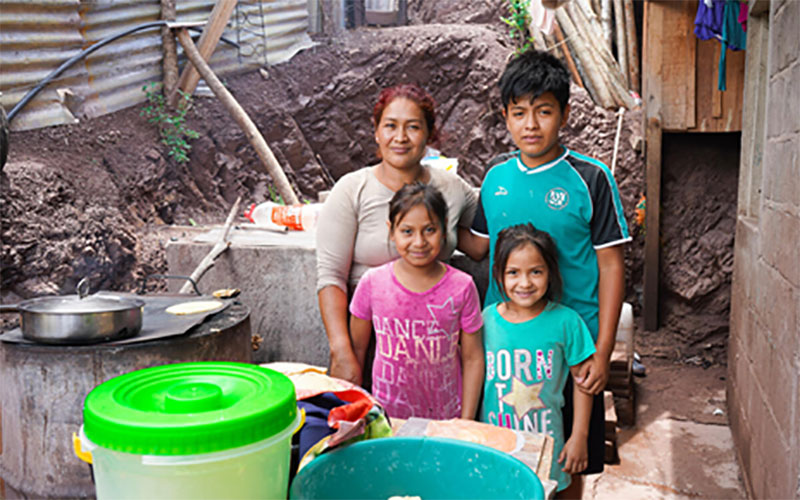 In Honduras, Luz (left) and her children received critical food rations during COVID-19 lockdowns. Without humanitarian assistance, children in some of the country’s more fragile regions may join a gang in order to survive. Photo: André Guardiola
Emergencies in Canada vs. around the world
In Honduras, Luz (left) and her children received critical food rations during COVID-19 lockdowns. Without humanitarian assistance, children in some of the country’s more fragile regions may join a gang in order to survive. Photo: André Guardiola
Emergencies in Canada vs. around the world
Factors like government and economic stability (or lack thereof) can make a big difference to the likelihood and severity of emergencies facing populations. So can factors like the degree and quality of infrastructure in a country.
Picture floodwaters rising in your community here in Canada, for instance – something that happens every year in some provinces. They might take over your home and business location, leaving you nowhere to sleep and no way to earn money. For weeks or months, you might sleep on the floor of the local arena, with hundreds of other people.
Canada’s stable society and economy – as well as our geographic location and the lack of complicating factors like war – would greatly reduce the threat of a crisis here. Here in Canada, humanitarian assistance is forthcoming when we need it. We would rapidly receive the basic essentials and some help getting back on our feet.
Now picture living in Afghanistan, or the Democratic Republic of Congo. Violent conflict may be a constant threat where you live. To compound the danger, imagine a drought shriveling your crops – and the soaring cost of food wiping out your savings. Your children are gaunt, listless, and in desperate need of medical care.
What if the people in your community have run out of things to share? What if the sounds of conflict are coming closer? What if most of your neighbours have packed up and left, walking for days or weeks to seek humanitarian assistance? You would very likely do the same – even if it means leaving your home and livelihood.
 Rohingya families in this refugee camp in Bangladesh fled violent persecution in Myanmar. Thousands have been without shelter since . Without humanitarian assistance, people in dire situations would often not survive. Photo: Xavier Sku
Rohingya families in this refugee camp in Bangladesh fled violent persecution in Myanmar. Thousands have been without shelter since . Without humanitarian assistance, people in dire situations would often not survive. Photo: Xavier Sku
In emergencies like these, people’s own governments are either unable or unwilling to meet their most immediate needs: clean water, food, shelter, medication and protection. And people of all ages are at risk of illness and death if humanitarian assistance doesn’t come quickly.
What’s causing humanitarian crises nowadays?
Here are some of the global trends prompting the need for humanitarian assistance in 2021, according to the latest Global Humanitarian Overview:
- COVID-19 has triggered the deepest global recession since the 1930s, causing extreme poverty to rise for the first time in 22 years. By June 2020, with global COVID-19 cases exceeding 10 million, humanitarian assistance requests were coming from governments who didn’t normally require this kind of help.
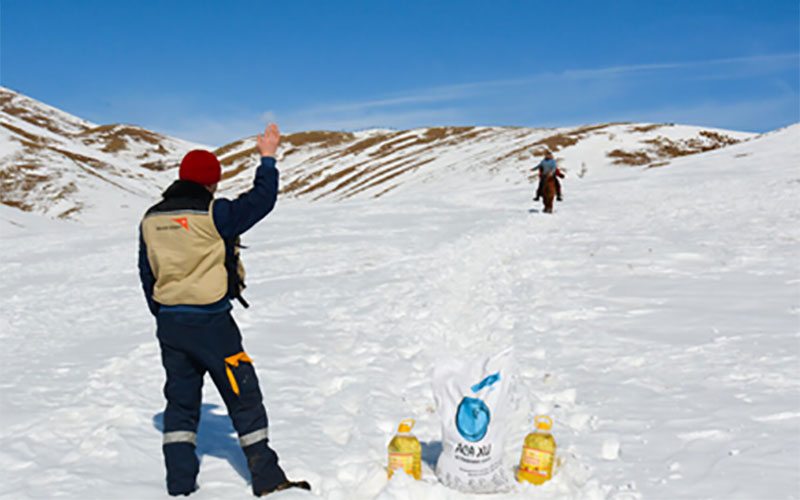 In Mongolia, World Vision has provided humanitarian assistance to families in some of the most remote regions. COVID-19 has intensified a situation that was already worsening. Floods, dust storms, droughts, wildfires and earthquakes have all affected livelihoods in recent years. Photo: Otgonkhuu Dashdorj
In Mongolia, World Vision has provided humanitarian assistance to families in some of the most remote regions. COVID-19 has intensified a situation that was already worsening. Floods, dust storms, droughts, wildfires and earthquakes have all affected livelihoods in recent years. Photo: Otgonkhuu Dashdorj
- Political conflicts are more intense and more violent, at a devastating cost to civilians. For the ninth year running, more than 90 per cent of casualties from explosive weapons in populated areas were civilians. This took an extreme toll on families and local economies, dragging more people into extreme poverty.
 South Sudan is a country rocked by multiple dangers at once, including climate emergencies and civil conflict. Humanitarian aid – like emergency food for young children – is what stands between millions of people and illness or death. Photo: Scovia Faida Charles
South Sudan is a country rocked by multiple dangers at once, including climate emergencies and civil conflict. Humanitarian aid – like emergency food for young children – is what stands between millions of people and illness or death. Photo: Scovia Faida Charles
- Hunger is soaring with conflict as the main driver of acute hunger. The pandemic, coupled with climate change, has drastically affected food systems around the world. In appeals for humanitarian assistance, funds requested for food security rose to $9 billion US in 2020. That’s a dramatic increase from $5 billion US in 2015.
- Climate change is worsening situations for families in around the world. The past 10 years were the hottest on record. They increased severe and frequent weather events as well as natural hazards. Climate change increased the need for humanitarian aid, particularly in regions where families were already vulnerable.
- What’s the difference between ‘humanitarian aid’ and ‘humanitarian assistance’?
For the purposes of this article, we will alternate between both. Nowadays, however, many people prefer the term ‘humanitarian assistance’ to the more old-fashioned ‘humanitarian aid.’ The former better reflects the resourcefulness people show in emergency situations.
‘Humanitarian aid’ can imply that people are helpless without the help of wealthier countries. As with the term ‘first aid’, we picture people too weak, sick, injured or vulnerable to be partners in their care and recovery.
In reality, however, surviving crises like civil conflict and natural disasters requires formidable strength and endurance on the part of those affected.
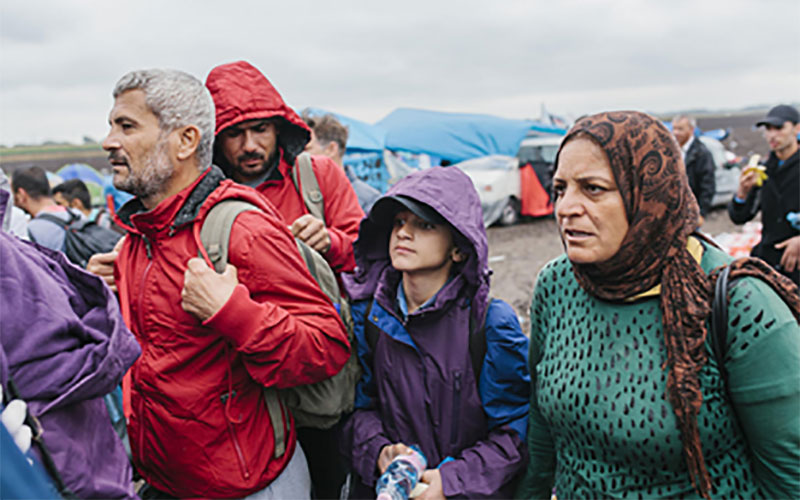 In 2015, Syrian refugees feeling violent conflict shepherded their families some 1,800 km to a transit point camp in Serbia, carrying possessions and young children. Photo: Jo Currie
In 2015, Syrian refugees feeling violent conflict shepherded their families some 1,800 km to a transit point camp in Serbia, carrying possessions and young children. Photo: Jo Currie
In an emergency situation, people and communities take countless actions to protect and care for their families. They are not idle recipients of ‘aid’ from countries like Canada. Rather, we are ‘assisting’ them in their efforts to provide for their families in the short-term – and start the process of rebuilding.
One way World Vision does this is through our
cash and voucher-based programs. We meet families’ urgent needs in the short term. But from there, we help parents and caregivers get back on their feet, providing for their families while restoring their communities.
Not only does this approach help restore dignity to families who’ve lost everything, as they make their own choices about purchases. It helps contribute to what is often a battered local economy.
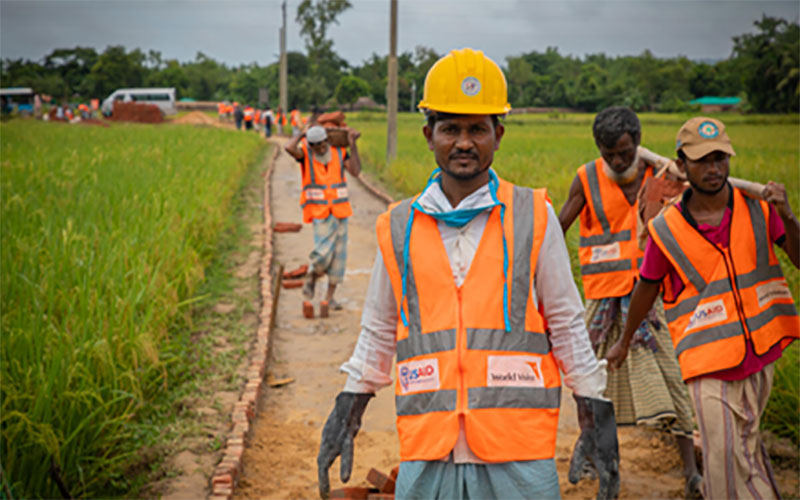 In Bangladesh, Rohingya parents in the Cox’s Bazar refugee camp are earning income while rebuilding an important local road. Not only does this help restore dignity – it will make accessing emergency hospital care much easier in a crisis. Photo: Shabir Hussain
In Bangladesh, Rohingya parents in the Cox’s Bazar refugee camp are earning income while rebuilding an important local road. Not only does this help restore dignity – it will make accessing emergency hospital care much easier in a crisis. Photo: Shabir Hussain
- Does humanitarian assistance make a difference?
Humanitarian assistance not only saves lives – it rebuilds futures. Here are five essential benefits of humanitarian aid.
Humanitarian assistance
protects childhoods by:
- responding to the essential needs of families with children to raise, protecting children’s futures and helping keep parents alive to care for them.
- giving families alternatives to marrying their daughters as children, a decision which affects a child for the rest of her life.
- keeping parents and caregivers alive to provide, so children don’t need to assume adult roles – including taking hazardous jobs.
- rebuilding schools and providing essential education supplies for children to learn, so education can continue.
- creating ‘child-friendly spaces’ as safe places for children to gather when their communities are in chaos (this can be the time when they are most vulnerable to physical and sexual abuse).
Humanitarian assistance
protects local economies by rebuilding livelihoods and also infrastructure like boreholes, roads and bridges. Families who can earn income and transport their wares to market can better provide for their children and hire other workers.
Humanitarian assistance
guards against other threats including
waterborne illness. Other threats include
food crisis. Exposure is also a real danger for families sleeping in the open air. Humanitarian assistance
helps keep communities rooted. When people can access life’s essentials near where they live – and receive help rebuilding their incomes – they’re less likely to uproot their families and travel long distances for help. Children can grow up amongst people who know and care for them, like teachers, community leaders and extended family.
Humanitarian assistance
protects ‘host communities’ in other areas who might otherwise absorb an influx of displaced people. Many such communities are already struggling to meet their own needs. Supporting thousands of people from displaced communities can lead to increased tension/conflict between groups.
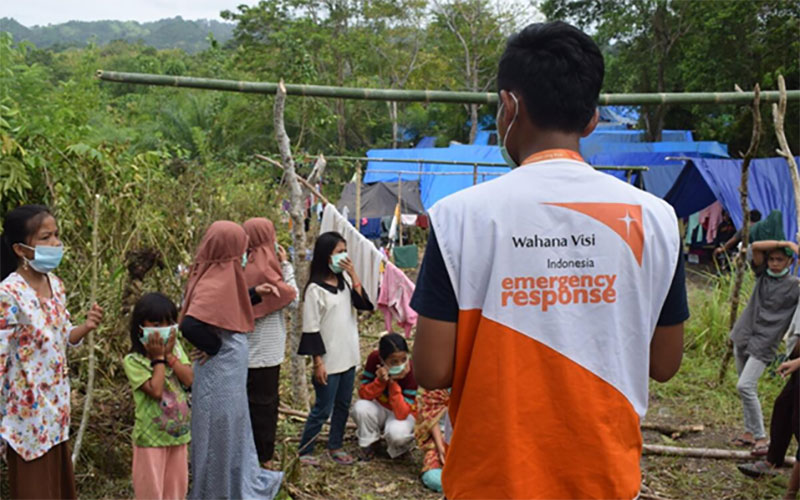 A deadly earthquake shook entire regions of Indonesia in January 2021, displacing more than 70,000 people. World Vision was quick to scene. Humanitarian aid workers cared for families with essentials like food, water and supplies for temporary shelter. Photo: Lisa Hernawati
A deadly earthquake shook entire regions of Indonesia in January 2021, displacing more than 70,000 people. World Vision was quick to scene. Humanitarian aid workers cared for families with essentials like food, water and supplies for temporary shelter. Photo: Lisa Hernawati
- What are the challenges of providing humanitarian assistance?
Since governments bear the primary responsibility for meeting civilians’ needs, international bodies like the United Nations must negotiate humanitarian access for organizations like World Vision. Governments must consent to receiving humanitarian help – even in situations where they can’t provide for their people or are unwilling to do so.
Once granted entry, humanitarian workers often face myriad challenges.
- The infrastructure required to reach vulnerable areas – roads and airport runways for example – may be bombed, flooded or destroyed by rockslides.
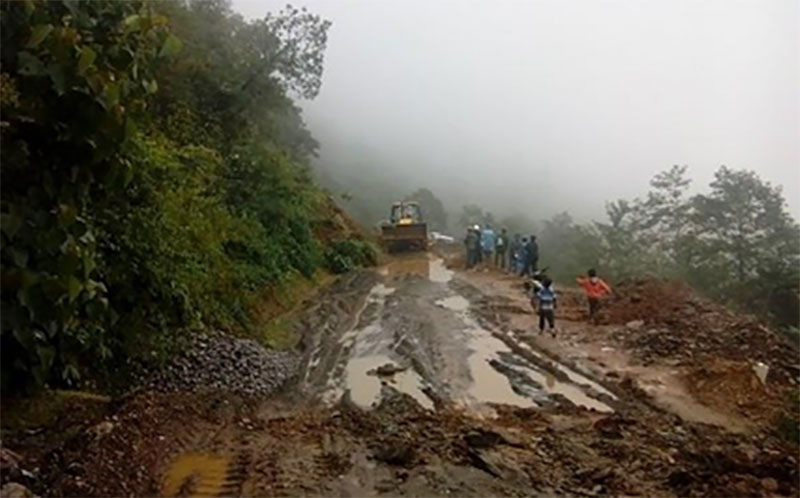 Floods and landslides can destroy humanitarian aid channels leading to communities facing emergency situations. This can render them nearly impossible to access with aid deliveries, until the way is cleared. Such delays can put people in even greater danger. Photo: Nang Suan Mung
Floods and landslides can destroy humanitarian aid channels leading to communities facing emergency situations. This can render them nearly impossible to access with aid deliveries, until the way is cleared. Such delays can put people in even greater danger. Photo: Nang Suan Mung
- Emergencies are becoming larger, longer lasting and more complex. Increasingly, available humanitarian assistance funding is insufficient to meet the needs. In 2020, the UN Refugee Agency was drastically underfunded, with funding gap of 51 per cent.
- Why can’t people’s own countries look after them?
According to the Government of Canada’s web site, the
primary responsibility for providing aid in emergency situations lies with the government of the affected country. Often, people’s communities and their governments do provide a significant first response.
But the needs of communities in crisis situations can exceed their government’s capacity, readiness and willingness to respond.
That’s when the ‘humanitarian imperative’ comes into play – the fundamental humanitarian principle giving everyone “the right to receive aid and the right to offer it”.
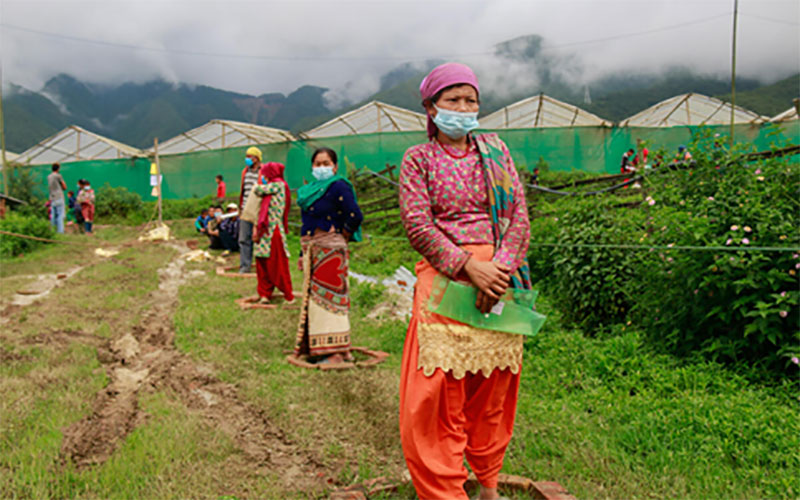 Workers at a brick factory in Nepal line up to receive food humanitarian assistance. Floods, landslides and wildfires are regularly occurring threats the country. Climate change is making such extreme weather events more frequent, and unpredictable. Photo: Garima Chaulagain
Workers at a brick factory in Nepal line up to receive food humanitarian assistance. Floods, landslides and wildfires are regularly occurring threats the country. Climate change is making such extreme weather events more frequent, and unpredictable. Photo: Garima Chaulagain
Some groups and individuals expand on this definition, believing that
providing humanitarian assistance is also a responsibility. Groups like World Vision often feel ‘called’ to this kind of work, their workers committing to travelling long distances into dangerous regions to provide aid.
- What is Canada’s approach to humanitarian assistance?
Canada, like many wealthy nations, recognizes that people’s own governments have the first responsibility to assist them. But when the needs of populations in crisis exceed what their countries can provide, Canada steps up to help.
- Canada helps communities around the globe according to people’s most urgent needs.
- These might include safe drinking water, sanitation services, emergency health care, food and temporary shelters.
- Canada provides grants to experienced humanitarian partners (like World Vision Canada) who are responding to the crisis and support local partners already on the ground.
- These groups include the United Nations, the Red Cross Movement, Canada’s Humanitarian Coalition and other non-government organizations like World Vision Canada.
- World Vision, in turn, partners with organizations like the World Food Programme to distribute food assistance to vulnerable communities (more than 12 million people in 2020 alone).

In Honduras, COVID-19 lockdowns have kept thousands of families from their jobs and likelihoods. Humanitarian assistance – food in particular – is helping parents like Luz to nourish their children. Photo: André Guardiola
The four humanitarian principles
Canada makes decisions about humanitarian assistance in accordance with
the four humanitarian principles of humanity, neutrality, impartiality and independence. Here is what each stands for:
- Humanity – human suffering must be addressed wherever it is found, with particular attention to the most vulnerable.
- Neutrality – humanitarian assistance must not favour any side in an armed conflict or other dispute.
- Impartiality – humanitarian assistance must be provided solely on the basis of need, without discrimination.
- Independence – humanitarian objectives should be separate from political, economic, military or other objectives.

Food security programs are just one way World Vision helps prevent some disasters from occurring – or lessens their impact. Peace-building and economic development programs, as well as disaster-preparedness training, are some others. Photo: Aggrey Nyondwa
- What’s the difference between humanitarian assistance and development assistance?
Both are critical in today’s world.
Here is the explanation from Canada’s Humanitarian Coalition of charities, of which World Vision is a member.
- Humanitarian assistance is designed to save lives and alleviate suffering during and in the immediate aftermath of emergencies, whereas
- Development assistance responds to ongoing structural issues, particularly systemic poverty. Such issues “may hinder economic, institutional and social development in any given society.” Development assistance also helps build capacity to ensure resilient communities and sustainable livelihoods.
It’s important to note that this siloed, ‘either-or approach’ to assistance is evolving. It’s being replaced by an approach known as the
‘humanitarian-peace-development nexus’. This is a hot topic within the humanitarian sector and maximizes the overlap between the transitions between the two forms of assistance.
World Vision’s intended approach moving forward, is to leverage
humanitarian, development – and also peacebuilding – efforts toward realizing the rights of children living in
fragile contexts.

In 2017, thousands of children in the Philippines lived through a five-month-long conflict between the country’s government and armed militants. Nearly 360,000 people were displaced, many requiring humanitarian assistance. World Vision is now training young people to be peacebuilders, empowering them for the future. Photo: Earl Janubas
Conversely, most of World Vision’s humanitarian assistance programs have some kind of development aspect. One example is ‘building back better’ when rebuilding schools, homes and community centres, so the structures hold up in the next typhoon.
More and more humanitarian programs have recognized the life-saving nature of incorporating education for children, particularly since millions of the world’s girls and boys are spending their entire childhoods in refugee camps.
- What are some objections to humanitarian assistance?
Some people are uncomfortable with the idea of humanitarian assistance, feeling it’s the responsibility of a country’s own government to help its people. Some feel that countries have the
right to manage their own crises, without outside involvement. Some people fear the possibility of relief supplies end up in the hands of the wrong parties e.g., combatants in conflict situations.
However, most people here in Canada don’t feel concerned about spending ‘too much’ on humanitarian assistance. The percentage of Canada’s budget directed to the world’s most vulnerable people is still comparably small: just
28 cents for every $100 of our Gross National Income in 2020.
A poll commissioned by Cooperation Canada in 2020 indicated
Canadians support more spending on international aid. The poll indicated that 74 per cent of respondents want Canada to either play a leading role, or at least match the contributions of similar developed countries.
- How can I help provide humanitarian assistance?
When an emergency strikes, organizations like World Vision and the Humanitarian Coalition often
issue appeals to Canadians. Canadians can partner in the emergency response by making donations. Sometimes these are matched by the Canadian government, increasing the power of each donation.
Another way to help is through
World Vision’s Raw Hope initiative, which runs continuously in dangerous, turbulent regions of countries like Afghanistan, the Democratic Republic of Congo, Honduras and South Sudan. Raw Hope stands with children who’ve experienced some of the worst that life can offer, including war, food crisis, disease and abuse.
In helping children recover, Canadians can also help them become more resilient in the face of any future emergencies. It’s a way to invest in the future of fragile regions, not simply respond with crisis hits.
Donate to Raw Hope today